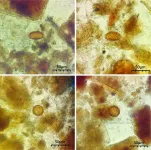You're in luck. Rice University biologist Kory Evans has the answer.
"Flatfishes are some of the weirdest vertebrates on the planet, and they got weird very, very fast by changing multiple traits at once over a short period of time," said Evans, an assistant professor of biosciences at Rice who specializes in studying the evolution of fish over long time scales.
Of all mammals, reptiles, birds, amphibians and fish, flatfish are easily the most asymmetric. Evans, the corresponding author of a study on flatfish evolution in the Proceedings of the National Academy of Sciences, said it helps to keep that in perspective.
"Imagine any other animal," he said. "Like, say you're out walking and you see a squirrel, and one eye is here and the other is there," he said, pointing to two places on the same side of his face. "That squirrel is having a bad time. And there are 800 species of these fish that just do that.
"Perspective helps for understanding how weird these animals actually are."
In evolutionary terms, flatfish asymmetry isn't just a novelty, it's an innovation, and a trait that sets flatfish far apart from even their closest relatives.
Evans said flatfish evolution is particularly interesting because they began as typical, symmetrical fish. They started evolving their current shape, or morphology, about 65 million years ago, and within 3 million years, they'd largely finished.
"We got all that novel colonization of morphospace in 3 million years' time," Evans said. "And look how much time has passed since then. So there's a really brief and short period of time when they evolved all these new forms and all these crazy species."
In their study, Evans and co-authors Olivier Larouche of Rice and Sara-Jane Watson of the New Mexico Institute of Mining and Technology found that tight integration of genetic traits in flatfish led to a sort of evolutionary cascade.
"Integration is where there's a high degree of correlation between traits, such that if you change one trait, another trait will be changed as well," Evans said. "At macroevolutionary timescales, this gets really interesting, because traits then begin to co-evolve with one another. So if you change one trait, you might end up changing several others."
He said traits can become more integrated if their morphological development is controlled or influenced by shared gene interaction networks.
"If the signaling networks expand to encompass more and more traits, then you can theoretically smear changes all across an entire organism using the same signaling network, and you can change really fast," he said. "It's like pressing one button and flipping the whole animal all at once."
Evans, Larouche and Watson used several methods to piece together the story of flatfish evolution. One was a phylogenetic comparative method that tracks the evolutionary history of traits between and among species. Phylogenetic trees have branches that show where species diverge. "Typically, the tree is built using genetics," Evans said. "So, maybe we'll have a bunch of genomes for all those species. And we can use that to figure out who's more closely related to who. Then, once the tree is built, I can see how traits have changed over time using the branching pattern of the tree as a guide."
The researchers also used a micro-CT scanner in the Evans lab to make 3D scans of the skulls of several flatfish species. The scans were used to make 3D morphometric models that could be compared for differences in shape. But many flatfish species are so dissimilar that it wasn't possible to "tease them apart with just shape or just phylogeny alone," Evans said.
So the researchers created complex mathematical models to track the degree of integration between different regions of the skull across the 65-million-year history of flatfishes and their relatives.
"We found that flatfishes were way more integrated than non-flat fishes, and what this means is that the evolution of asymmetry for flatfishes ended up being an integrated process, basically, involving changes all across the skull," he said. "As the eye migrated, a bunch of other things changed as well. And it became additive. So as the flatfish skull got more and more integrated, more things began to change, per unit time, than a generation before."
As to why flatfish evolved to be asymmetrical, Evans said it wasn't the only path to becoming flat.
"Other fishes that are flat did not do this, like stingrays," he said. "They just went flat like a pancake. But their eyes aren't both on the same side. The remora (aka suckerfish) are also a flat-looking fish, and they didn't do that."
Given evolution is a competition for "survival of the fittest," the evolutionary success of flatfish begs the question: Is asymmetry somehow advantageous?
"I'm not gonna lie," Evans said. "I don't really know if there's an advantage. I think they did it because they could."
INFORMATION:
Additional co-authors include Stacy Farina of Howard University, Maria Laura Habegger of the University of North Florida and Matt Friedman of the University of Michigan.
Research support was provided by the National Science Foundation.
Links and resources:
The DOI of the PNAS paper is: 10.1073/pnas.2101330118
A copy of the paper is available at: https://doi.org/10.1073/pnas.2101330118
High-resolution IMAGES are available for download at:
https://news-network.rice.edu/news/files/2021/04/0503_FLATFISH-ke81-lg.jpg
CAPTION: Rice University bioscientist Kory Evans with a 3D printed skull of a jack, a close symmetrical relative of flatfish. Evans and colleagues found flatfish rapidly evolved their asymmetric shape thanks to highly integrated networks of genes that controlled the shapes of their skulls. (Photo by Jeff Fitlow/Rice University)
https://www.flickr.com/photos/51647007@N08/5188111786
CAPTION: Sash flounder flatfish. (Photo courtesy of SEFSC Pascagoula Laboratory; Collection of Brandi Noble, NOAA/NMFS/SEFSC)
https://news-network.rice.edu/news/files/2021/04/0503_FLATFISH-ke52-lg.jpg
CAPTION: Kory Evans preparing to examine a fish with a microscope in his Rice University laboratory. (Photo by Jeff Fitlow/Rice University)
https://news-network.rice.edu/news/files/2021/04/0503_FLATFISH-kegp86-lg.jpg
CAPTION: Rice University bioscientists (from left) Kory Evans, Sean Trainor and Jojo West in Evans' laboratory at Rice. (Photo by Jeff Fitlow/Rice University)
This release can be found online at news.rice.edu.
Follow Rice News and Media Relations via Twitter @RiceUNews.
Located on a 300-acre forested campus in Houston, Rice University is consistently ranked among the nation's top 20 universities by U.S. News & World Report. Rice has highly respected schools of Architecture, Business, Continuing Studies, Engineering, Humanities, Music, Natural Sciences and Social Sciences and is home to the Baker Institute for Public Policy. With 3,978 undergraduates and 3,192 graduate students, Rice's undergraduate student-to-faculty ratio is just under 6-to-1. Its residential college system builds close-knit communities and lifelong friendships, just one reason why Rice is ranked No. 1 for lots of race/class interaction and No. 1 for quality of life by the Princeton Review. Rice is also rated as a best value among private universities by Kiplinger's Personal Finance.





